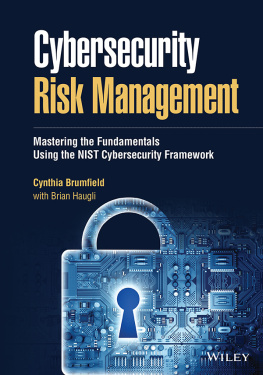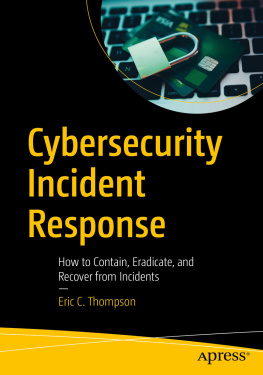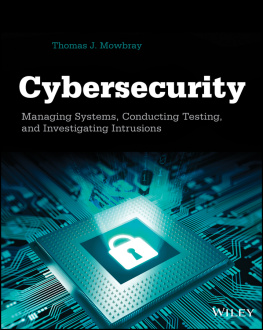Cynthia Brumfield - Cybersecurity Risk Management: Mastering the Fundamentals Using the NIST Cybersecurity Framework
Here you can read online Cynthia Brumfield - Cybersecurity Risk Management: Mastering the Fundamentals Using the NIST Cybersecurity Framework full text of the book (entire story) in english for free. Download pdf and epub, get meaning, cover and reviews about this ebook. year: 2022, publisher: Wiley, genre: Business. Description of the work, (preface) as well as reviews are available. Best literature library LitArk.com created for fans of good reading and offers a wide selection of genres:
Romance novel
Science fiction
Adventure
Detective
Science
History
Home and family
Prose
Art
Politics
Computer
Non-fiction
Religion
Business
Children
Humor
Choose a favorite category and find really read worthwhile books. Enjoy immersion in the world of imagination, feel the emotions of the characters or learn something new for yourself, make an fascinating discovery.
- Book:Cybersecurity Risk Management: Mastering the Fundamentals Using the NIST Cybersecurity Framework
- Author:
- Publisher:Wiley
- Genre:
- Year:2022
- Rating:5 / 5
- Favourites:Add to favourites
- Your mark:
Cybersecurity Risk Management: Mastering the Fundamentals Using the NIST Cybersecurity Framework: summary, description and annotation
We offer to read an annotation, description, summary or preface (depends on what the author of the book "Cybersecurity Risk Management: Mastering the Fundamentals Using the NIST Cybersecurity Framework" wrote himself). If you haven't found the necessary information about the book — write in the comments, we will try to find it.
In Cybersecurity Risk Management: Mastering the Fundamentals Using the NIST Cybersecurity Framework, veteran technology analyst Cynthia Brumfield, with contributions from cybersecurity expert Brian Haugli, delivers a straightforward and up-to-date exploration of the fundamentals of cybersecurity risk planning and management. The book offers readers easy-to-understand overviews of cybersecurity risk management principles, user, and network infrastructure planning, as well as the tools and techniques for detecting cyberattacks. The book also provides a roadmap to the development of a continuity of operations plan in the event of a cyberattack.
With incisive insights into the Framework for Improving Cybersecurity of Critical Infrastructure produced by the United States National Institute of Standards and Technology (NIST), Cybersecurity Risk Management presents the gold standard in practical guidance for the implementation of risk management best practices.
Filled with clear and easy-to-follow advice, this book also offers readers:
- A concise introduction to the principles of cybersecurity risk management and the steps necessary to manage digital risk to systems, assets, data, and capabilities
- A valuable exploration of modern tools that can improve an organizations network infrastructure protection
- A practical discussion of the challenges involved in detecting and responding to a cyberattack and the importance of continuous security monitoring
- A helpful examination of the recovery from cybersecurity incidents
Perfect for undergraduate and graduate students studying cybersecurity, Cybersecurity Risk Management is also an ideal resource for IT professionals working in private sector and government organizations worldwide who are considering implementing, or who may be required to implement, the NIST Framework at their organization.
Cynthia Brumfield: author's other books
Who wrote Cybersecurity Risk Management: Mastering the Fundamentals Using the NIST Cybersecurity Framework? Find out the surname, the name of the author of the book and a list of all author's works by series.






